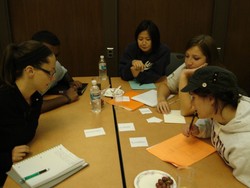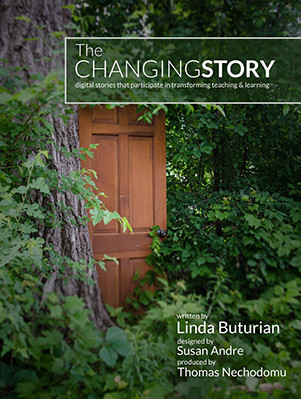
This blog focuses on my scholarship in my five research projects: learning assistance and equity programs, student peer study group programs, learning technologies, Universal Design for Learning, and history simulations. And occasional observations about life.
Peer-Led Team Learning helps minority students succeed

Active learning methods have been shown to be superior to traditional lecture in terms of student achievement, and our findings on the use of Peer-Led Team Learning (PLTL) concur. Students in our introductory biology course performed significantly better if they engaged in PLTL. There was also a drastic reduction in the failure rate for underrepresented minority (URM) students with PLTL, which further resulted in closing the achievement gap between URM and non-URM students. With such compelling findings, we strongly encourage the adoption of Peer-Led Team Learning in undergraduate Science, Technology, Engineering, and Mathematics (STEM) courses.
The entire annotated bibliography of more than 1,100 citations concerning postsecondary peer cooperative learning programs can be downloaded by clicking the following link, http://z.umn.edu/peerbib
The causal effects of the Peer Assisted Study Sessions (PASS) on educational outcomes

This report summarises the results of a HEPPP-funded research project on the effects of the Peer Assisted Study Sessions (PASS) on educational outcomes. The study used a randomised encouragement design (RED), which avoids the potential problem of selection bias that pervades non-experimental evaluations. Globally, this is the first large-scale experiment on the effectiveness of PASS or related Supplemental Instruction programmes.The study population consists of 6954 student subject observations from 14 first-year courses at the University of Wollongong in Australia in 2014 and 2015. Following the RED approach, a randomly selected sub-group was offered a large, near-cash incentive to participate in PASS. Whilst PASS participation is voluntary and unrestricted, participation was 0.47 sessions (19 percent) greater for the incentivised group compared to the non-incentivised group. This inducement effect is larger for students from low-SES areas (0.89 sessions). But the overall inducement effect is smaller than anticipated, which limits the statistical power of the main analysis, especially for subgroups. We also varied the size of the incentive greatly between semesters, but this did not meaningfully change the size of the inducement effect. The design of effective incentives for student populations warrants further research. The experiment suggests that one hour of PASS improved grades by 0.065 standard deviations (1.26 marks on a raw 100-point scale), which is consistent with the non-experimental literature. However, this estimate is not statistically significant, reflecting limited statistical power. The estimated effect is largest and statistically significant for students in their first semester at university (0.153 standard deviations or almost 3 marks per hour of PASS). This particular sub-group analysis was not in our preanalysis plan, and so it should be treated as a suggestive–rather than a confirmatory –result. Nevertheless, it remains plausible given issues around transitioning into a university environment, including the more independent, self-directed study skills and time management required in tertiary study, as well as the need for structure and social support. We had intended to study heterogeneity of effects for a number of other subgroups (by socioeconomic status, rural and indigenous backgrounds, age, sex, domestic/international status, and high school grades), but this was not feasible because of limited statistical power.
To download the complete annotated bibliography of 1,100+ citations of postsecondary peer cooperative learning programs, click on the following link, http://z.umn.edu/peerbib
Mathematics communication within the frame of Supplemental Instruction – SOLO and ATD analysis

Teaching at Swedish primary and secondary schools is often combined with collaborative exercises in a variety of subjects. One such method for learning together is Supplemental instruction (SI). Several studies have been made to evaluate SI in universities throughout the world, while at lower levels hardly any study has been made until now. This study aimed at identifying learning conditions in SI-sessions at two Swedish upper secondary schools. Within this study, a combination of ATD (Anthropological theory of the didactic) and the SOLO-taxonomy (Structure of the Observed Learning Outcome) was successfully tried as an analysis strategy.
To access the complete annotated bibliography of more than 1,100 references to postsecondary peer cooperative learning programs, click on the following link, http://z.umn.edu/peerbib
Assessing the impact of a muilti-disciplinary Peer Led-Team Learning program on undergraduate STEM education.
 Carlson, K., Celotta, D. T., Curran, E., Marcus, M., & Loe, M. (2016). Assessing the impact of a muilti-disciplinary Peer Led-Team Learning program on undergraduate STEM education. Journal of University Teaching & Learning Practice, 13(1), article 1. Retrieved from http://ro.uow.edu.au/cgi/viewcontent.cgi?article=1570&context=jutlp.
Carlson, K., Celotta, D. T., Curran, E., Marcus, M., & Loe, M. (2016). Assessing the impact of a muilti-disciplinary Peer Led-Team Learning program on undergraduate STEM education. Journal of University Teaching & Learning Practice, 13(1), article 1. Retrieved from http://ro.uow.edu.au/cgi/viewcontent.cgi?article=1570&context=jutlp.
There has been a national call to transition away from the traditional, passive, lecture-based model of STEM education towards one that facilitates learning through active engagement and problem solving. This mixed methods research study examines the impact of a supplemental Peer-Led Team Learning (PLTL) program on knowledge and skill acquisition for students in introductory biology, chemistry, calculus and applied statistics courses. Results indicate program participants reliably outperform their matched pairs in courses that emphasize quantitative reasoning. Moreover, program participants report acquiring important insights about learning, collaboration, and engagement in undergraduate STEM education. These results are consistent with previous findings on PLTL and also provide insight into the roles of course context and student population on program outcomes.
To download the entire annotated bibliography of over 1,100 references to postsecondary peer cooperative learning programs, click on the following web link, http://z.umn.edu/peerbib
2016 Annotated Bibliograpy of Postsecondary Peer Cooperative Learning Programs Updated

This annotated bibliography does not attempt to be inclusive of this broad field of literature concerning peer collaborative learning. Instead, it is focused intentionally on a subset of the educational practice that shares a common focus with increasing student academic achievement and persistence towards graduation.
The seven student peer learning programs included in this bibliography meet the following characteristics: (a) the program must have been implemented at the postsecondary or tertiary level; (b) the program has a clear set of systematic procedures for its implementation that could be replicated by another institution; (c) program evaluation studies have been conducted and are available for review; (d) the program intentionally embeds learning strategy practice along with review of the academic content material; (e) the program outcomes include increased content knowledge, higher final course grades, higher pass rates, and higher college persistence rates; and (f) the program has been replicated at another institution with similar positive student outcomes. From a review of the professional literature, six programs emerged: (a) Accelerated Learning Groups (ALGs), (b) Emerging Scholars Program (ESP), (c) Peer Assisted Learning (PAL), (d) Peer-Led Team Learning (PLTL), (e) Structured Learning Assistance (SLA), (f) Supplemental Instruction (SI), and (g) Video-based Supplemental Instruction (VSI). As will be described in the following narrative, some of the programs share common history and seek to improve upon previous practices.Other programs were developed independently.
Regrets for scholarship I have overlooked. Please send me items you think should be included in the next edition. Happy reading.
Free eBook for teachers and students to create digital stories
 The Changing Story: Digital stories that participate in transforming teaching & learning by Linda Buturian http://www.cehd.umn.edu/the-changing-story/ Free download as iBook or ePub formats for other devices through this website.
The Changing Story: Digital stories that participate in transforming teaching & learning by Linda Buturian http://www.cehd.umn.edu/the-changing-story/ Free download as iBook or ePub formats for other devices through this website.
If you are interested in having your students create digital stories or creating them as part of your learning activities, I recommend the following free eBook. Linda is a colleague of mine in our academic department at UMN. I have used principles from this book for digital stories that my students have constructed. It is a powerful experience for those who create them as well as everyone who views them.
This truly is a "must read" if you are interested in digital storytelling. Rather than just focusing on shallow techniques to quickly use the latest app to produce a video, the author takes us on the journey through the eyes of students and teachers why this approach is such a powerful and transformative learning experience. This experience occurs for both those who watch as well as those who create them. I enjoyed the embedded video clips from the teachers and samples of student-produced work. Plus the writing style of the author is accessible, enjoyable, and nuanced. Don't miss this book just because it is free.
Description by the author: “The Changing Story gives you assignments, resources, and examples to use in your teaching and learning. It will also help you think of ways digital stories can be used in your teaching, and help students harness the power of visual storytelling. The Changing Story is a free ebook that is downloadable and licensed with Creative Commons.”
2016 David Arendale's Directory of iPad Apps for Classroom and Personal Use
 2016 David Arendale's Directory of iPad Apps is available for downloading.
2016 David Arendale's Directory of iPad Apps is available for downloading.
<Click on this link to download the 2016 directory.>
The Apple iPad continues to grow with the number of users and the enormous number of apps available for downloading, many of which are free. The latest count is approaching two million. My directory contains my favorite 300 I use personally and with my work as a college history professor. I am excited to see how I experience them on the iPad Pro that I will be purchasing in December.
